Monday 13 March 2006
Puerto Madryn - Punto Norte (Peninsula
Valdes): 175km
We drive to Puerto Piramides
on the Peninsula Valdes.
At the entrance of the National Park we pay35 (€10) pesos
entry fee. 25km after the park entrance we stumble upon a visitor centre, but
that is a disappointment. The viewing tower is nice though, offering view of the
entire peninsula. We continue Piramides where we have a coffee with a view of
the beach and the bay. 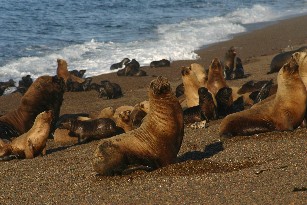 It is warm, at least 23 degrees. Then we go on to Punta Norte. Via an unsealed
road the 76 km trip takes about an hour and a half. We arrive there around 11am.
We will the night at the Estancia La
Ernestina. An Estancia is a kind of ranch or farm. The maid thinks it
strange that we the big double bed instead of the twin beds. She keeps
insisting, but I tell her that this is the way we want it. After that we apparently
have lost all sympathy with the women in charge of house keeping, because from
then on she give us the cold shoulder and keeps conversation to the bare
minimum.
It is warm, at least 23 degrees. Then we go on to Punta Norte. Via an unsealed
road the 76 km trip takes about an hour and a half. We arrive there around 11am.
We will the night at the Estancia La
Ernestina. An Estancia is a kind of ranch or farm. The maid thinks it
strange that we the big double bed instead of the twin beds. She keeps
insisting, but I tell her that this is the way we want it. After that we apparently
have lost all sympathy with the women in charge of house keeping, because from
then on she give us the cold shoulder and keeps conversation to the bare
minimum. 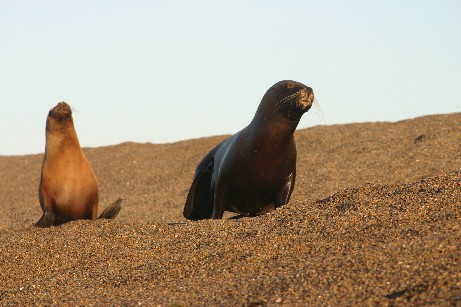 We
are in time for lunch, which is served at 1pm. We also meet Juan, the man who
does the excursions. He is very friendly and nice and speaks excellent English.
After lunch we have a look at Punta Norte itself. Large groups of sea lions live
here on the beach. We can see them from the top of the dunes. The beach itself
is not freely accessible. At high tide the young sea lions will be attacked by
Orca's beaching themselves. It is way past high tide now and there is no Orca in
sight. The last sighting was on 8 March (5 days ago) without an attack on the
sea lions. We have chat with an American guy from Maine who as come here
for the day to see the spectacle, but alas in vain. We return to the Estancia.
At 5pm Juan takes us and the other guests in a Landrover to a stretch of beach
belonging to the Estancia. We drive off the road through the Dunes and stop
close to the beach. We get out of the car and walk onto the beach. A group of
sea lions is resting on the beach a bit further away. We have to approach the
group on our hands and knees. We slowly crouch towards with with intervals in
order to not to frighten them and to give them the chance to get used to us. We
are in time for lunch, which is served at 1pm. We also meet Juan, the man who
does the excursions. He is very friendly and nice and speaks excellent English.
After lunch we have a look at Punta Norte itself. Large groups of sea lions live
here on the beach. We can see them from the top of the dunes. The beach itself
is not freely accessible. At high tide the young sea lions will be attacked by
Orca's beaching themselves. It is way past high tide now and there is no Orca in
sight. The last sighting was on 8 March (5 days ago) without an attack on the
sea lions. We have chat with an American guy from Maine who as come here
for the day to see the spectacle, but alas in vain. We return to the Estancia.
At 5pm Juan takes us and the other guests in a Landrover to a stretch of beach
belonging to the Estancia. We drive off the road through the Dunes and stop
close to the beach. We get out of the car and walk onto the beach. A group of
sea lions is resting on the beach a bit further away. We have to approach the
group on our hands and knees. We slowly crouch towards with with intervals in
order to not to frighten them and to give them the chance to get used to us. 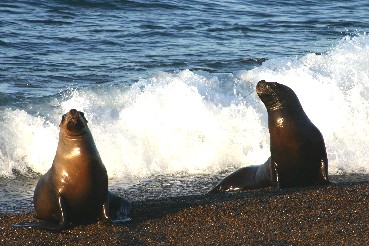 We
get as close as 20 metres. Then one of the sea lions gets very interested and
walks towards us. We get a bit nervous, but Juan whispers that it is allright.
Just sit still. Then an older sea lion intervenes and and ushers his younger
companion back to the group. We make lots of photos, but not nearly as many
as our fellow guests. Most of them are nature photographers and biologists. Then
Juan starts serving Gin & Tonic from the cooler. Small groups of curious sea
lions swim by us. A dead tired penguin stumbles onto the beach, but because of
lack of fellow penguins he returns to the water. We
get as close as 20 metres. Then one of the sea lions gets very interested and
walks towards us. We get a bit nervous, but Juan whispers that it is allright.
Just sit still. Then an older sea lion intervenes and and ushers his younger
companion back to the group. We make lots of photos, but not nearly as many
as our fellow guests. Most of them are nature photographers and biologists. Then
Juan starts serving Gin & Tonic from the cooler. Small groups of curious sea
lions swim by us. A dead tired penguin stumbles onto the beach, but because of
lack of fellow penguins he returns to the water.
At night we
eat a simple meal at the estancia. Then we are off to bed but lights are out at
10.30pm. A generator provides electricity here between 8pm and 10.30pm only.
There is no phone and only limited amounts of water. This is really the end of
the world.
Weather:
sunny 25 degrees
Tuesday 14 March 2006
Punto Norte - Caldera Valdes - Punta
Delgada - Trelew: 301km
After
breakfast we clear the room. The weather is great: sun, the sea is calm and the
tide will be very high. According to Juan excellent 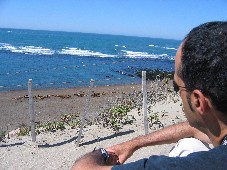 conditions
for Orca's. At 11.30 it is high tide. We are at the lookout at 10 and start
waiting. More people join us, but the Orca's do not. We stay until 1pm baking in
the sun and staring vainly at the horizon searching for the characteristic fins.
We give up. We drive along the coast towards Caldera Valdes, where we should see
a colony of Elephant Seals. That is a disappointment. conditions
for Orca's. At 11.30 it is high tide. We are at the lookout at 10 and start
waiting. More people join us, but the Orca's do not. We stay until 1pm baking in
the sun and staring vainly at the horizon searching for the characteristic fins.
We give up. We drive along the coast towards Caldera Valdes, where we should see
a colony of Elephant Seals. That is a disappointment. Most of them have left. Just a handful can be seen at quite a distance. We
continue for 50km to Punta Delgada, another 25km further south. This should also
be a good spot for Elephant seals. Be here too we are too late. The group has
already left for the season. All in all a disappointing expedition. We drive
back in the direction of Puerto Piramides (75km), continuing via Puerto Madryn
(another 93km) to Trelew (again 58km). Quite a drive for one day. We arrive at
6pm at hotel Galicia in Trelew. The same as last Friday.
Most of them have left. Just a handful can be seen at quite a distance. We
continue for 50km to Punta Delgada, another 25km further south. This should also
be a good spot for Elephant seals. Be here too we are too late. The group has
already left for the season. All in all a disappointing expedition. We drive
back in the direction of Puerto Piramides (75km), continuing via Puerto Madryn
(another 93km) to Trelew (again 58km). Quite a drive for one day. We arrive at
6pm at hotel Galicia in Trelew. The same as last Friday.
At night we
eat at La Eloisa again. I order a Cordero Patagonica, Patagonian Lamb, directly
from the asador.
Weathe: very
sunny and warm. 27 degrees.
Wednesday 15 March 2006
Trelew
- Buenos Aires: 1130km (1:48 u flight)
After
breakfast we drive early to the airport. The man from Hertz is waiting for us
and we can return the car quickly. The check-in staff is less expedient and we
have to wait another ten minutes or so. They give us exit row seats. After
check-in we hear an announcement saying that the staff of the oil company in
Trelew is on strike today and we will have to make an extra stop in Bahia Blanca
to refuel. Flying in Argentina is not easy. The flight, apart from the strong
turbulence, is uneventful and we land 15 minutes behind schedule in Buenos
Aires. The driver that was supposed to pick us up is 15 minutes late, but at
least he is there. He drives us to the hotel within 15 minutes, as the domestic
airport is almost next to the city centre on the banks of the Rio del Plata. 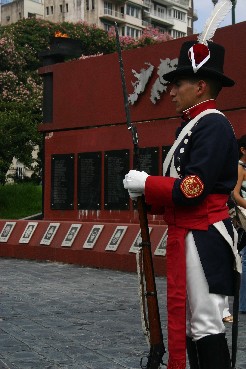 We
stay at Hotel
BoBo. A luxurious trendy hotel in the hip Palermo neighbourhood. It is a
small hotel with only seven rooms and we get all teh attention we want from the
good looking staff. We
stay at Hotel
BoBo. A luxurious trendy hotel in the hip Palermo neighbourhood. It is a
small hotel with only seven rooms and we get all teh attention we want from the
good looking staff.
We have lunch in
the hotel and then take the Underground
or Subte to the Retiro borough. Here we do a walk starting at the
monument for the fallen soldiers in the Falkland war (Malvinas). On
the monument we see the names of all the soldiers killed engraved in marble
slates. Two soldiers are on guard. The square once called Plaza Britannica is
now called Plaza des Fuerzas Armadas (Square of the Armed Forces) and ironically
enough is opposite the Engelse viewing tower. That tower was a gift of the
British community on the occasion of the 100th birthday of the Argentine
Republic. After the Falkland war there were plans to tear down the tower, but
that never happened. It is now called Torre
Monumental and has a striking resemblance with London's Big Ben (only
smaller). Unfortunately is closed to the public. 
We have to get
used to the hustle and bustle of the big city, havig spent 3 weeks in the
countryside. There are 13 million people living in Buenos Aires. We adjust
quickly and the Porteños are a pleasant crowd to be with. The people leave
space for each other and are well behaved. We continue and walk past some
former family palaces, built in the early 20th century for extremely wealthy
families. Like the Palacio San Martin of the Ancheno family, now a reception
house for state visits. The Anchenos, are the basis for the Argentine
expression "as rich as an Ancheno". During the great depression the
Achenos lost everything. We walk on through the posh Calle Alvear and enter the
Recoleta district. We pass the Nuncius residence (where pope John Paul II stayed
during his visits here), the Residencia Duhau and the Palacio Hume both once
family residences in the Recoleta district. Main attraction of the street 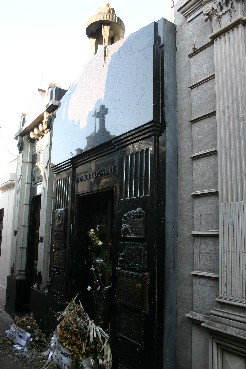 is the
Grand Hotel Palacio Alvear, the grandest hotel in the city and favorite with
politicians, heads of state and the rich in general. A bit further on, on the Plaza San Martín de
Tours we find the Nuestra Senora
del Pilar chruch. It is the parish church for Recoleta's elite. A fine restored
18th century church. Next to it is the entrance to the Recoleta cemetery. A very
desirable place to be buried. Just like the one in Punta Arenas, the cemetery is
a district in its own right, full of impressive family mausoleums. To get your
spot here, connections with top families or hero status are essential. It is
therefore not self-evident that Evita
Duarte de Peron (1919-1952) would be buried here. Eva Duarte was of humble origins
was never really accepted by the elite. Her husband
president Juan Peron (1895-1974), could not get a grave for himself here. The
Duarte family mausoleum is not so ostentatious, but it is plastered with plates
from various organisatons, like the trade union of taxi drivers, with praise and
quotations from her speeches. Wilted flowers are in front of it. More space is
devoted to former presidents and the heroes of the ware against Paraguay
(guarded by bronze soldiers) or the leaders of the 1890 revolution. Funny is the
grave of boxer Firpo, who fought Joe Dempsey in 1923. A statue of him stands
beside grave, showing the man in his gown and gloves. We take a taxi back to the
hotel.
is the
Grand Hotel Palacio Alvear, the grandest hotel in the city and favorite with
politicians, heads of state and the rich in general. A bit further on, on the Plaza San Martín de
Tours we find the Nuestra Senora
del Pilar chruch. It is the parish church for Recoleta's elite. A fine restored
18th century church. Next to it is the entrance to the Recoleta cemetery. A very
desirable place to be buried. Just like the one in Punta Arenas, the cemetery is
a district in its own right, full of impressive family mausoleums. To get your
spot here, connections with top families or hero status are essential. It is
therefore not self-evident that Evita
Duarte de Peron (1919-1952) would be buried here. Eva Duarte was of humble origins
was never really accepted by the elite. Her husband
president Juan Peron (1895-1974), could not get a grave for himself here. The
Duarte family mausoleum is not so ostentatious, but it is plastered with plates
from various organisatons, like the trade union of taxi drivers, with praise and
quotations from her speeches. Wilted flowers are in front of it. More space is
devoted to former presidents and the heroes of the ware against Paraguay
(guarded by bronze soldiers) or the leaders of the 1890 revolution. Funny is the
grave of boxer Firpo, who fought Joe Dempsey in 1923. A statue of him stands
beside grave, showing the man in his gown and gloves. We take a taxi back to the
hotel.
Early
evening we have cocktails at café El Taller on Calle J. Luis Borges. A
traditional jazz bar with outside tables on a busy square in the midst of
Palermo Viejo district. We have dinner a few doors away from our hotel at restaurant
Pilares. A trendy restaurant with good food.
Weather: grey day, 24 graden,
humid. Later clear and sunny.
Thursday 16 March 2006
This morning
it is raining. We take the underground into town. The train is crowded and
pressingly warm. We do a walk around the 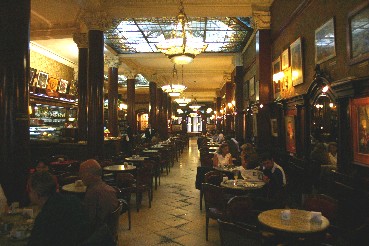 centre,
starting at the Via de
Mayo, de grand boulevard running from Plaza de Mayo and the presidential palace
to Plaza de Congresso and the parlemiament building. We take a coffee break at Café
Tortoni, a classic. It has been around since 1859 and has welcomed many
celebrities, among whom writers and other artists, but also dignitaries like the
King of Spain, Hillary Clinton and Gabriela Sabatini, to name but a few. After
coffee and cake we carry on in the rain and arrive at the Congress or
parliament. A grand neoclassic building on a green square. On the square is tent
with an exhibition on the atrocities committed by the military centre,
starting at the Via de
Mayo, de grand boulevard running from Plaza de Mayo and the presidential palace
to Plaza de Congresso and the parlemiament building. We take a coffee break at Café
Tortoni, a classic. It has been around since 1859 and has welcomed many
celebrities, among whom writers and other artists, but also dignitaries like the
King of Spain, Hillary Clinton and Gabriela Sabatini, to name but a few. After
coffee and cake we carry on in the rain and arrive at the Congress or
parliament. A grand neoclassic building on a green square. On the square is tent
with an exhibition on the atrocities committed by the military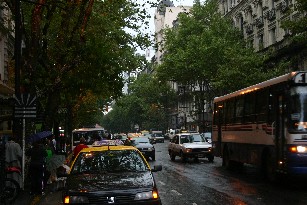 dictatorship
(1976-83). This commemorates the 30th anniversary of the military coup. It
reminds us of a dark era that took many lives and destroyed those of many
others. We also walk through a tiny street, Pasaje de la Piedad, next to
theBartolome Mitre, between Parrana and Montevideo. A picturesque alleway with
old lanterns and palm trees. The street is closed off with a fence, so we have
to sneak in after someone, which is no problem.
dictatorship
(1976-83). This commemorates the 30th anniversary of the military coup. It
reminds us of a dark era that took many lives and destroyed those of many
others. We also walk through a tiny street, Pasaje de la Piedad, next to
theBartolome Mitre, between Parrana and Montevideo. A picturesque alleway with
old lanterns and palm trees. The street is closed off with a fence, so we have
to sneak in after someone, which is no problem.
We walk on,
turn right onto Avenida de Calao. It is really pouring down now and we have to
take shelter in one of the many bookstores. When the rain starts to wain we turn
right again into the Avenida Corrientes. This is also a busy boulevard. After a
while we get to the café La Paz, where once left wing intellectuals gathered.
The café still breathes the calm and intellectual atmosphere. We have a
coffee there. Later we turn left to the Plaza Lavalle and get a look at the Teatro
Colon, when another thunderstorm erupts. We can just manage to take shelter
under the theatre's front loggia. The entrance for visits and the box office is
in a passage running between
Tucuman and Viamonte. When we find it we manage to book a space on one of the
many tours (English or Spanish). We can joing the 2.45 tour. The tour is great
and shows us everything, including rehearsal rooms, set workshops, stage prop
stores etc. It is a large organisation in full swing. In the large auditorium
rehearsals are going on for La
look at the Teatro
Colon, when another thunderstorm erupts. We can just manage to take shelter
under the theatre's front loggia. The entrance for visits and the box office is
in a passage running between
Tucuman and Viamonte. When we find it we manage to book a space on one of the
many tours (English or Spanish). We can joing the 2.45 tour. The tour is great
and shows us everything, including rehearsal rooms, set workshops, stage prop
stores etc. It is a large organisation in full swing. In the large auditorium
rehearsals are going on for La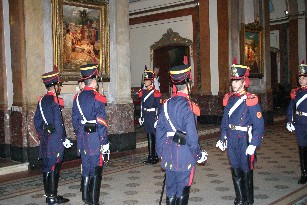 Bohème. Unfortunately we are only allowed to take pictures in the lobby. After
teh tour we continue our walk and cross the wide boulevard 9 de Julio
(more than 12 lanes wide). In the middle is the obelisk (67 metres high). In 1931
was erected celbrating 4 occasions: the two attempts at founding the city, the
day of the flag and appointing the city the federal capital. It is a rallying
point for hooting cars whenever football fans are celebrating a victory. Our
walk ends at the Catedral Metropolitana at Plaza de Mayo. A church with a 19th
century appearance in neoclassical style, but with a history going back to the
18th century. In the church is the grave of General San Martin, hero of
Argentine independence and liberator of Argentina, Chile and Peru. Two soldiers
stand guard. Just as we are about to leave a group of soldiers is marching in to
change the guard.
Bohème. Unfortunately we are only allowed to take pictures in the lobby. After
teh tour we continue our walk and cross the wide boulevard 9 de Julio
(more than 12 lanes wide). In the middle is the obelisk (67 metres high). In 1931
was erected celbrating 4 occasions: the two attempts at founding the city, the
day of the flag and appointing the city the federal capital. It is a rallying
point for hooting cars whenever football fans are celebrating a victory. Our
walk ends at the Catedral Metropolitana at Plaza de Mayo. A church with a 19th
century appearance in neoclassical style, but with a history going back to the
18th century. In the church is the grave of General San Martin, hero of
Argentine independence and liberator of Argentina, Chile and Peru. Two soldiers
stand guard. Just as we are about to leave a group of soldiers is marching in to
change the guard.
We take a taxi
back to the hotel. Early
evening we have cocktails in the hotel bar and delicious dinner in the
restaurant.
After dinner
we take a taxi to the Constitución district. We are going to a 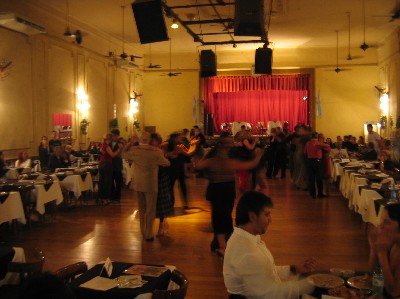 Milonga.
That is a tango night where the Porteños let their hair hang down and excel in
their favourite dance. Our taxi driver drives even faster and more reckless than
the ones we had so far. He overtakes left and right, almost brushes against
other cars and our hearts miss several beats in the process. The Milonga is very
popular with both young and old. This milonga is called Niño Bien
and takes place in a community centre. A dj plays tango classics and most
gentlemen do their best with the ladies of their choice. Very relaxed, everyone
is having a good time. Some do a couple of rounds and then leave, others stay on
their feet all night. We stay for a couple of hours and cannot believe our eyes. Milonga.
That is a tango night where the Porteños let their hair hang down and excel in
their favourite dance. Our taxi driver drives even faster and more reckless than
the ones we had so far. He overtakes left and right, almost brushes against
other cars and our hearts miss several beats in the process. The Milonga is very
popular with both young and old. This milonga is called Niño Bien
and takes place in a community centre. A dj plays tango classics and most
gentlemen do their best with the ladies of their choice. Very relaxed, everyone
is having a good time. Some do a couple of rounds and then leave, others stay on
their feet all night. We stay for a couple of hours and cannot believe our eyes.
Weather: grey day
with heavy showers. Some sunny spells. 19 degrees.
|
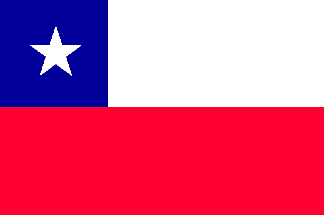

 Most of them have left. Just a handful can be seen at quite a distance. We
continue for 50km to Punta Delgada, another 25km further south. This should also
be a good spot for Elephant seals. Be here too we are too late. The group has
already left for the season. All in all a disappointing expedition. We drive
back in the direction of Puerto Piramides (75km), continuing via Puerto Madryn
(another 93km) to Trelew (again 58km). Quite a drive for one day. We arrive at
6pm at hotel Galicia in Trelew. The same as last Friday.
Most of them have left. Just a handful can be seen at quite a distance. We
continue for 50km to Punta Delgada, another 25km further south. This should also
be a good spot for Elephant seals. Be here too we are too late. The group has
already left for the season. All in all a disappointing expedition. We drive
back in the direction of Puerto Piramides (75km), continuing via Puerto Madryn
(another 93km) to Trelew (again 58km). Quite a drive for one day. We arrive at
6pm at hotel Galicia in Trelew. The same as last Friday.